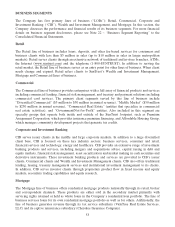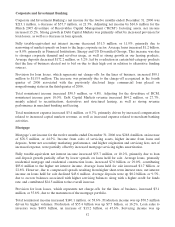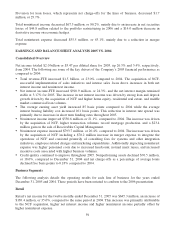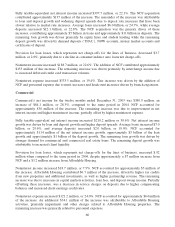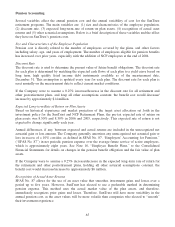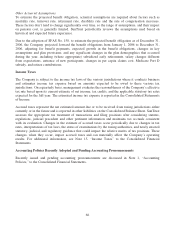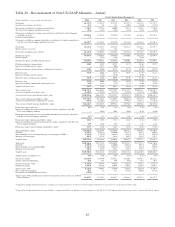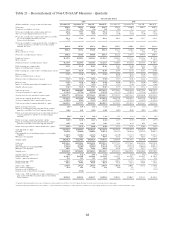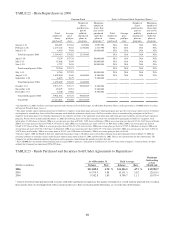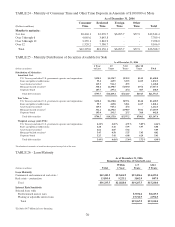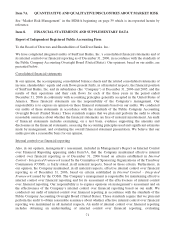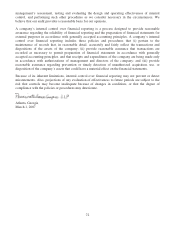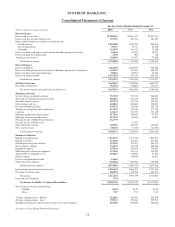SunTrust 2006 Annual Report Download - page 76
Download and view the complete annual report
Please find page 76 of the 2006 SunTrust annual report below. You can navigate through the pages in the report by either clicking on the pages listed below, or by using the keyword search tool below to find specific information within the annual report.Noninterest income increased $90.9 million. NCF added approximately $44 million in noninterest
income. Additionally, securities losses decreased by $32.3 million.
Noninterest expense increased $33.9 million, or 62.8%. NCF added approximately $118 million of
noninterest expense in addition to the $74.8 million increase in merger expense representing costs to
integrate the operations of NCF. Additionally, increases in corporate overhead expenses of $98.1 million
were partially offset by increased expense recovery from the lines of business in the amount of $256.6
million.
CRITICAL ACCOUNTING POLICIES
The Company’s significant accounting policies are described in detail in Note 1, “Accounting Policies,”
to the Consolidated Financial Statements and are integral to understanding Management’s Discussion
and Analysis of Results of Operations and Financial Condition. Management has identified certain
accounting policies as being critical because they require management’s judgment to ascertain the
valuation of assets, liabilities, commitments and contingencies and they have a significant impact on the
financial statements. A variety of factors could affect the ultimate value that is obtained either when
earning income, recognizing an expense, recovering an asset, or reducing a liability. The Company’s
accounting and reporting policies are in accordance with US GAAP, and they conform to general
practices within the applicable industries. The Company has established detailed policies and control
procedures that are intended to ensure these critical accounting estimates are well controlled and applied
consistently from period to period. In addition, the policies and procedures are intended to ensure that
the process for changing methodologies occurs in an appropriate manner. The following is a description
of the Company’s current accounting policies that are considered to involve significant management
judgment.
Allowance for Loan and Lease Losses
The allowance for loan and lease losses represents the Company’s estimate of probable losses inherent
in the existing loan portfolio. The ALLL is increased by the provision for loan losses and reduced by
loans charged off, net of recoveries. The ALLL is determined based on management’s assessment of
reviews and evaluations of larger loans that meet the Company’s definition of impairment and the size
and current risk characteristics of pools of homogeneous loans (i.e., loans having similar characteristics)
within the portfolio.
Impaired loans, except for smaller balance homogeneous loans, include loans classified as nonaccrual
where it is probable that SunTrust will be unable to collect the scheduled payments of principal and
interest according to the contractual terms of the loan agreement. When a loan is deemed impaired, the
amount of specific allowance required is measured by a careful analysis of the most probable source of
repayment, including the present value of the loan’s expected future cash flows, the fair value of the
underlying collateral less costs of disposition, or the loan’s estimated market value. In these
measurements, management uses assumptions and methodologies that are relevant to estimating the
level of impaired and unrealized losses in the portfolio. To the extent that the data supporting such
assumptions has limitations, management’s judgment and experience play a key role in enhancing the
ALLL estimates.
General allowances are established for loans and leases grouped into pools that have similar
characteristics, including smaller balance homogeneous loans. The ALLL Committee estimates
probable losses by evaluating several factors: historical loss experience, current internal risk ratings
based on the Company’s internal risk rating system, internal portfolio trends such as increasing or
decreasing levels of delinquencies, concentrations, and external influences such as changes in economic
or industry conditions.
63


